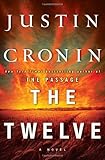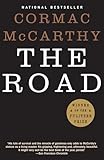1.

 In The Passage, Justin Cronin introduced us to a nightmarish dystopia. The Twelve is the second installment of a planned trilogy, so if you haven’t read The Passage then you probably don’t want to read this review, but here’s a quick recap just in case: in the world of The Passage, a virus has been discovered in the Amazon that turns human beings into monsters. These are vampires, but vampires far less human-like than any other variants I’ve seen in the genre. Infection turns them into fanged and clawed creatures with skin like armor, virtually immortal, who live on blood and move with inhuman speed.
In The Passage, Justin Cronin introduced us to a nightmarish dystopia. The Twelve is the second installment of a planned trilogy, so if you haven’t read The Passage then you probably don’t want to read this review, but here’s a quick recap just in case: in the world of The Passage, a virus has been discovered in the Amazon that turns human beings into monsters. These are vampires, but vampires far less human-like than any other variants I’ve seen in the genre. Infection turns them into fanged and clawed creatures with skin like armor, virtually immortal, who live on blood and move with inhuman speed.
The American government decides to experiment and see if they can’t somehow weaponize the discovery, but they need test subjects. Who, they consider, are the most disposable members of our society? Who won’t be missed? Death row inmates without families. Twelve men are carefully selected from death rows around the country. They are offered a choice: they can stay in prison and await their inevitable executions, or they can leave with the mysterious men who’ve arrived to visit them. They’re taken to a top-secret facility in Colorado, injected with various strains of the virus, and studied.
Until of course the unthinkable happens and the monsters escape, because what else is going to happen in the early pages of a novel with caged monsters, and a hundred years later the North American continent is a desolate wasteland, monsters hiding in the abandoned cities and the last few humans struggling to survive. The Twelve picks up where The Passage left off, with the various survivors of the first book scattered among the continent’s last few settlements, one of the Twelve dead, and the other eleven and their followers having hunted so successfully that they’re running out of people to eat and are beginning to starve to death.
Once again Cronin has superbly handled the difficult task of writing a character-driven adventure story. But whereas The Passage concerned itself primarily with the dynamic of good people struggling to survive a world infested with bad monsters, The Twelve focuses largely on an aspect of the apocalypse that Cronin touched on only lightly in the first installment: the vampires remain terrifying, but they’re arguably less terrifying than the humans who have decided to collaborate with them in order to survive.
2.
A surprise of The Twelve is that Cronin continues to move the narrative back and forth in time, from the shock of the initial outbreak to the depopulated wasteland that exists a century later. This has the dual effect of allowing him to further fill out a rich and complex back-story and also to rather neatly address one of the major criticisms of the first book, which I saw expressed most frequently along the lines of Seriously? We’re supposed to believe that someone thought it was a good idea to turn death-row inmates into immortal blood-sucking monsters?
Personally, I have no problem accepting the notion that any given group of reasonably intelligent people is perfectly capable of collectively coming up with a very, very dumb idea, but Cronin meets it head-on:
So it was that Deputy Director Horace Guilder (were there any actual directors anymore?) had found himself sitting before the Joint Chiefs… to offer his official assessment of the situation in Colorado. (Sorry, we made vampires; it seemed like a good idea at the time.) A full thirty seconds of dumbfounded silence ensued, everyone waiting to see who would speak next.
A century after his extremely awkward meeting with the Joint Chiefs, Guilder has become a hybrid, a creature who maintains human form and will not age so long as he keeps drinking the blood of a vampire’s familiar. He presides over a nightmare city in Iowa, a corporate dictatorship populated by slaves, human collaborators, and a small army of creatures like himself who dress in suits and drink blood.
There are small moments of humor in amidst the horror — as in most corporations, no department is more dreaded than HR — but Cronin’s vision is dark. No dissent is tolerated in Guilder’s city. Uncooperative citizens are fed to the vampires. Public executions aren’t unheard-of. Rapes and beatings abound.
Cronin takes the precaution of starting his books with a fair-sized cast of major characters, so that the population doesn’t thin out too drastically when the body count inevitably starts to rise, but all writers of apocalyptic fiction have to contend with the tension of wanting to depict their fictional worlds as nearly unsurvivable, without killing off too many of their major characters. As one character remarks, it’s a big continent, but once parted, his characters have a way of reuniting against impossible odds, over spans of years and hundreds of miles. He is at ease in the realm of improbable coincidences.
The prose of The Twelve is somewhat uneven. The impression is of a fine writer working with an enormous amount of plot under a very tight deadline. There are moments when the prose is strictly utilitarian, other times when it slips into sentimentality. A summer day on the prairies is described as “hot-hot-hot.” But there are moments of sheer beauty, as in the last moments before a man, a mechanic who’s secretly a poet, sets himself on fire to avoid being taken up: “This ravishing world,” he thinks, in the last few heartbeats before he flicks the lighter, “this ravishing world…”
3.


 These are anxious times we live in, and new apocalypse novels appear with every publishing season. A few years back there was The Road and now the end of the world as we know it recurs again and again, from Cronin’s planned trilogy to Colson Whitehead’s Zone One to Peter Heller’s The Dog Stars to Karen Thompson Walker’s The Age of Miracles.
These are anxious times we live in, and new apocalypse novels appear with every publishing season. A few years back there was The Road and now the end of the world as we know it recurs again and again, from Cronin’s planned trilogy to Colson Whitehead’s Zone One to Peter Heller’s The Dog Stars to Karen Thompson Walker’s The Age of Miracles.
Cronin’s books, for all their brutality, have an ethereal quality that most other apocalypse books I’ve read lack. He has created a dark and brutal world, but his monsters are linked by dreams. The Twelve dream of their terrible crimes, and their multitudes of descendants dream the dreams of the Twelve.
Amy, a girl from the first book who remains (barely) human but who carries a modified version of the virus in her blood, has always been able to speak with vampires. She thinks of them as the dreaming ones. The multitudes of lost souls transformed into monsters are intelligent and vicious in the manner of any expert predator, but also they are lost. When she’s near them she hears their constant question in her head, who am I who am I who am I? In The Passage she kneels before a man who’s just been killed by them:
It came to her that the man’s name had been Willem. And the ones who had done it to Willem were sorry, so sorry, and she rose and said to them, It’s all right, go now and do not do this again if you can help it, but she knew they could not. They could not help it because of the Twelve who filled their minds with their terrible dreams of blood and no answer to the question but this:
I am Babcock.
I am Morrison.
I am Chavez.
I am Baffes-Turrell-Winston-Sosa-Echols-Lambright-Martinez-Reinhardt-Carter.
Cronin’s vampires are not individuals in any meaningful sense. They move in pods, they dream the dreams of their masters, and they don’t know who they were before they ceased to be human. The only names that fill their drifting thoughts are the names of the Twelve. The idea of the hive mind isn’t new, but the Borg never dreamed like this. The great mass of vampires are unspeakable, but in a strange way not entirely unsympathetic. Cronin’s skill as a storyteller keeps us immersed in their strange long dream.








